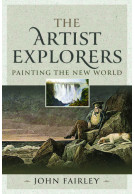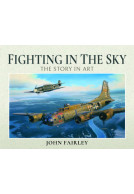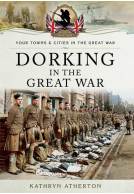Horses of the Great War (Hardback)
The Story in Art
Imprint: Pen & Sword Military
Pages: 135
ISBN: 9781473848269
Published: 10th November 2015
(click here for international delivery rates)
Order within the next 31 minutes to get your order processed the next working day!
Need a currency converter? Check XE.com for live rates
| Other formats available - Buy the Hardback and get the eBook for free! | Price |
|---|---|
| Horses of the Great War ePub (91.6 MB) Add to Basket | £6.99 |
Horses of the Great War uses a wide range of superb contemporary paintings to explain the contribution of countless innocent horses to the war effort and victory. These works supported by informed commentary tell how the horses were rounded up from all over the world in their hundreds of thousands; how the cavalry halted the German advance in 1914 and again in 1918; how Australian and Indian swept through the deserts of Palestine and Arabia, overwhelming the Turks and performing incredible feats of endurance.
The Western Front in France and Belgium relied on horses for supply of everything from shells and ammunition to food and water in atrocious and perilous conditions. While the vets kept the suffering horses alive and well, in the end, vast numbers were slaughtered or sold.
All this is reflected in the paintings of distinguished artists such as Sir John Lavery, Sir Alfred Munnings and Stanley Spencer who painted at the front.
The book will appeal beyond those fascinated by the war itself to all those of both sexes and all ages who relate to horses.
This book is fantastic, for the enthusiast of history, of art, of horses, you cannot miss in your library such a profound testimony of what was a huge sacrifice for beautiful animals.
Old Barbed Wire Blog
Read the full Italian review here
This is an illuminating and sobering book. If you have any interest in horses and history and the art that goes with them, you shouldn't miss this.
Racing Post, December 2016 – reviewed by Brough Scott
This is a splendidly illustrated book, given added value by the accompanying text, which helps place the pictures both in their immediate context, and in the wide context of the war and the huge demand for horse power.
John Rickard - History of War
Read the full review here.
The number of horses involved in the First World War was astonishing, likewise their feats of endurance. Millions went but few came back so this is a welcome account of their achievements in both words and pictures.
This England Summer 2016
The author, well known for his books on the equestrian art, has brought together a wonderful selection of contemporary paintings graphically illustrating the extraordinary contribution of countless innocent horses.
The Bulletin of the Military Historical Society No.264
Horses of the Great War with it's informative commentary and the wonderful paintings provides a brilliant reminder of our debt to man's faithful servant.
The many battle paintings of the Great War and magnificent and a timely reminder that the Army, including the cavalry, helped with some of the 'heavy lifting' during the Great War. Well done.
Scuttlebutt, ed. No 52, 2016 - John Roberts
The number of horses involved in the First World War was astonishing, likewise their feats of endurance. Millions went but few came back so this is a welcome account of their achievements in both words and pictures.
This England, Summer 2016
Although Allied cavalry halted some enemy advances, most equine work was moving ammunition, food, water and general supplies.
Horses of the Great War, with its lively narration and well-chosen imagery, contributes to a better understanding of the toll war takes on all of those who participate in battle, human and animal like.
Lesley Ann-Gentry
I cannot recommend it highly enough.
A beautiful book, richly illustrated throughout.
VaeVictus No.125
I do have an interest in modelling and I do have an interest in military history. So, when I first saw the title of this book I did wonder about what ideas a modeller might get from it for the colours and shading styles that might be transferable to painting small scale 3-dimensional models of horses. Whilst I did find it useful for this, I also discovered that it holds a lot more to interest the military historian about the period of WW1 as well...
Military Modelling Online - Robin Buckland
Today we think more about journalists and news camera crews going to cover war zones, but the illustrations that are used to illustrate the different elements of the story of the horse throughout the book also gives a good idea of the large number of artists who went out to cover the war. The paintings are a delight to see, while the story that surrounds them throws more light on the amazing contribution that horses made to the Great War, and the vast numbers that were involved. As I said at the outset, a book I might have passed by but I am so glad I didn't. Well worth reading and some fine ideas for modellers as well.
The big surprise of this book is quite how much horse action there was around the rest of the world.
Racing Post Sunday
This is an illuminating and sobering book. You should read it.
Horses of the Great War, with its lively narration and well-chosen imagery, contributes to a better understanding of the toll war takes on all of those who participate in battle, human and animal alike. I cannot recommend it highly enough.
Chiron Calling - Lesley Anne Gentry & Jamie Anne Gentry
It wasn’t just human beings on all sides in The Great War that paid a terrible cost, the horses they depended on paid just as high a price in death and suffering.
Destructive Music - Steve Earles
I doubt this could be better portrayed than in this beautifully produced collection of paintings of horses from The Great War. The text is learned and sympathetic and just right, while the reproductions of the paintings are superb. As with the previously reviewed ‘The Great War Illustrated: 1915’, every picture truly does tell a story.
A truly moving book highlighting a side of the Great War people don’t always think of…but should.
Published by Pen and Sword and retailing at modest £25.00 Fairley’s work has 134 pages containing over 65 stunning colour artworks. A quick flick of the pages and I was pleasantly surprised by the number of these that I had not seen previously; something I was not expecting. I was again satisfied to see works by my favourite artist Lucy Kemp-Welch, but her presence was to be expected on the pages of a work such this.
Toby Brayley, 'HorsePower' The Museum of the King's Royal Hussars in Winchester
I will not divulge too many of the artworks within the book as I feel it would spoil the reader’s enjoyment. The first image you are greeted with is “The Charge of Flowerdew’s Squadron” by Sir Alfred Cummings, portraying the charge of Lord Strathcona's Horse at the Battle of Moreuil Wood in March 1918. This choice of this magnificent work immediately sets the tone of the book; to see a full blown cavalry charge enacted as late as 1918 already casts aspersions on the common belief that the Cavalry, or even the horse had no part to play in a modern warfare where the machine gun, artillery and all of the recent innovations had cast our equine companions to pages of history nearly four years before.
The book starts with a brief introduction of horse life in the civilian world, namely in London. Interesting facts and statistics take us through their hard daily routines and usage to their unceremonious end in the capital’s slaughterers’ yards, then taking us on to the recruiting and procurement of the War Horses, again packed with facts and anecdotes from the period. I found the segment on the purchase of horses and their transport across North America very interesting, all accompanied by plenty of fantastic full page artworks by artists whose letters home and experiences feature in the text.
The rest of the book takes a reasonably brief, but more than adequate look into the use of Allied cavalry on the Western front, Salonika and the Middle East, offering a refreshing take on the actual successes and failures of the cavalry throughout the war. Further artworks by Bastien, Munnings and many others make a welcome appearance, all full page and in a quality print. Other chapters tell the story of the horses and the much forgotten mules of the artillery and transport units. The book finishes up with life on the home front and then finally the end of the war and the demobilisation and disposal of the horses. The facts and figures within this chapter do not make easy reading, no matter how many times you are exposed to them. All of the chapters are packed with facts, statistics and interesting stories that will more than hold the attention of most readers and especially those readers new to the subject. For myself the superb, well-chosen and varied style of artwork throughout really is the star attraction to this publication.
As the title suggests, this is no great in-depth study on the procurement, care or tactics in relation to equine usage during the war, for such information you will need to seek the works of Graham Winton or David Kenyon. However the information within is interestingly presented in a not-too sentimental way but in a passionate and digestible fashion, this is not entirely a “picture book”. I would consider myself well read and somewhat knowledgeable in the subject and the text did offer a number of new insights and plenty of accounts from individuals I had not come across previously. It is very refreshing to see a break away from the usual depiction of the cavalry in the Great War that has suffered from “the amnesia of hindsight” over the decades. The author is not overly biased and just as importantly not overly sentimental in his approach. Fairley’s work does go a small way to setting right a few myths and this impressed and rather surprised me.
At times the information can perhaps be somewhat simplistic and I would question some of the author’s nomenclature (Romney instead of Romsey), I also found the cropping and positioning of some of the artworks a little odd but these are just minor irritations within a brilliant work with a well researched and very interesting commentary. I admit to being biased on the subject, as you can imagine, especially as the 10th and the 11th Hussar’s get a brief mention, but the very affordable price for a book of this quality is worth it for the stunning artwork and the stories behind those pictures alone.
'Supported by informed, sympathetic and lively commentary and first-hand accounts...'
Malton & Pickering Mercury
'If history and horses, military and wars are your thing, Horses of the Great War will make for a fascinating read.'
Yorkshire Gazette & Herald
About John Fairley
John Fairley has written numerous books on equestrian art including The Art of the Horse, Racing in Art and Great Racehorses in Art. He was joint author of The Monocled Mutineer, which became a celebrated BBC television series.
A noted documentary and sports television producer, he was Director of Programmes at Yorkshire Television. Born in Liverpool, within sight of the Grand National course, he served as an RNVR officer aboard the aircraft carrier HMS Albion. A scholar of The Queen's College, Oxford, he is married, with three daughters, and lives in the Yorkshire racing town of Malton.




















